 | E-mail to Birds Korea |
 | KWBS |
in the Region
 | The Oriental Bird Club |
 | BirdLife International (Asia) |
August
Typically hot and humid (with day maxima often around 30°C until at least mid-month), with occasional heavy rains and strong winds, associated either with southern typhoons or caused by the mix of humidity and heat.
Chinese Egrets become widespread along the west coast. Shorebirds (including a very small number of Spoon-billed Sandpiper) begin to build up at many of the remaining best sites. Numbers tend to be rather lower than in spring, though Kentish Plover and Terek Sandpiper often number in the thousands in the southwest.
Parties of Black-naped Orioles, the appearance of returning leaf warblers (especially Eastern-crowned and Arctic Warblers) and small numbers of Brown Shrike and Yellow-rumped and Brown Flycatchers by mid-month also hint at the start of passerine migration, while Eurasian Hobby and Chinese Sparrowhawks appear to be on the move by the month's end. At the very end of August, the first migrant Pechora Pipit (probably of the subspecies menzbieri) and migrant buntings also appear on offshore Islands especially.
Seabirds have provided most interest in recent Augusts, with three records of Sooty Tern, Korea's first Sooty Shearwaters (in 2002), and a Lesser Frigatebird overflying Socheong and Korea's first Aleutian Tern seen from the Socheong ferry in 2004, with another in 2006.
(The following records are a compilation of our own sightings and records sent in by other observers. As well as being posted on the Birds Korea website(s), selected records are also forwarded to other Korean-language birding websites; records of threatened species are arranged and forwarded to Birdlife International and national authorities when appropriate; flag images and records are passed to bodies responsible for their coordination throughout the flyway; and all records sent to us are used to compile annual reports and to support the evolving understanding of the status of many of Korea’s birds.)
Igidae, Busan, August 31
One hour of seawatching in strong NE winds (of 6-8 m/s) produced only a steady line of Streaked Shearwater moving north, with ca 210 noted in very difficult viewing conditions. A juvenile Grey-streaked Flycatcher and a single Arctic Warbler were also noteworthy.
August 28, Igidae, Busan
Three hours of seawatching in light southeasterlies produced 520 Common Tern south (with 218 seen in a single scan), and the outstanding highlight a single (again long-range) adult Aleutian Tern, identified by generally much darker plumage, upperwing pattern, and distinctive head pattern, seen clearly in direct comparison with Common Tern. Again, diagnostic black bar on the secondaries suspected/seen but not clearly and the bird too far to photograph.
Other species of interest over the sea included an adult Pomarine Jaeger south, a feeding juvenile White-winged Black Tern, and at least 36 Red-necked Phalarope, while Grey-streaked Flycatcher and single Grey-tailed Tattler and Terek Sandpiper in the Park area were also noteworthy.
August 27, Igidae, Busan
Following rain and thundery showers on 27th (when 130 terns and 100+ Streaked Shearwater seen off shore in a single scan), one hour in the evening seawatching at Igidae, in Beaufort 2-3 southeasterlies and slightly hazy conditions. In 30 minutes, 825 Common Tern counted moving south as feeding, all in a single scan and a steady line, with the vast majority adults still in full breeding plumage (and less than 5% juveniles) . At least three Common-type adults mixed in appeared white-rumped but very dark, above and below, flew very bouyantly, and showed very diffusely dark and extensive uppersides to the primaries. All three were too far out to see any further plumage details. Also present, and rather closer, were 10+ Red-necked Phalarope, 4 Streaked Shearwater and a Common Kingfisher.
Eocheong Island, August 23
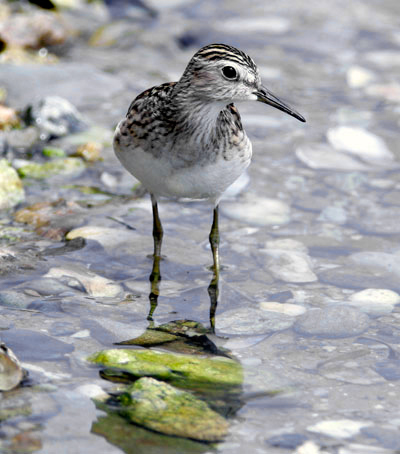
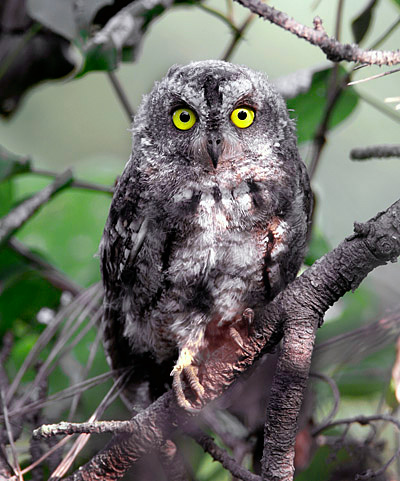
New birds this morning included 3 Chinese Grosbeak, and one more Forest Wagtail. 3 or 4 snipes in the vegetable garden prompted much discussion on ID, although one well- watched individual was clearly a Pintail Snipe on head pattern and behavior.
The return sea-crossing to Gunsan revealed a possible influx: 104 Streaked Shearwater, many gathered together in rafts of 15-20 birds: also 7 Common Tern, 1 Parasitic Skua and a Red-necked Phalarope.
August 22, Eocheong Island
No change in the weather, and similar birds, however 4 Eastern Crowned Warblers perhaps the first trickle of migration. A Common Sandpiper and Common Snipe were fresh in, as was a Forest Wagtail, Common Kestrel, 2 or 3 Chestnut Bunting, 1 Grey-streaked Flycatcher.
There were 10 Temmincks Cormorant lazing around the harbour, at least 10 Grey Wagtails flocking together, and seemingly more abundant Japanese White-eyes today. Variations in song and calls would seem to indicate both Japanese and Korean Bush Warblers.
The full range of cuckoos were on offer, giving good views and comparisons: a heavily barred/buffy female Indian Cuckoo, 3, possibly 4 small & slender Lesser Cuckoos, 1 or 2 Oriental Cuckoo (with characteristic relatively thick barring and dark tails), and a single finely barred Eurasian Cuckoo.
August 21, Eocheong Island
A very calm sea produced 14 Streaked Shearwater, 9 Red-necked Phalarope, 1 Common Tern, 2 unidentified (presumed Parasitic) Skuas, 3 Eurasian Curlews, and 5 Finless Porpoise.
Clear and hot weather with no recent rain and little breeze did not bode well for any migrants on the Island. Best was a juvenile Oriental Scops Owl (probably raised on the Island), 2 White-throated Needletails, and an obliging Long-toed Stint in the harbour.
Elsewhere, 5 Japanese White-eye, c.50 Pacific Swift, 1 Indian Cuckoo, several Korean Bush Warblers, and 1 Oriental Cuckoo (heard). Other birds included 2 Temminck's Cormorant, 2 Green Sandpiper, 6 Grey Wagtail, 1 Siberian Stonechat (juv), 1 Black-Capped Kingfisher, several Barn Swallows, and single Grey & Striated Herons, 1 Blue Rock Thrush, and 1 Intermediate Egret.
Gunsan, August 20

In the area of Oh-song Mountain, numerous Azure-winged Magpies and a Black-capped Kingfisher: on 2 nearby reservoirs, 3 Chinese Pond Heron, 2 Yellow Bitterns and 4 Red-rumped/Striated Swallows were noteworthy.
Along the Geumgang, 100+ Black-tailed Godwits, with 1 individual yellow-flagged (upper right leg) - see report below. Other waders of note included 9 Great Knot, several Common Redshank, 6 Grey-tailed Tattler and 2 Marsh Sandpipers. 1 "Bean" and 2 Greater White-fronted Geese were either early migrants or escapees from a Gunsan wildlife park.
Also notable was a male Garganey, and a flock of Kentish Plovers at the much dried out Saemangeum, making a total of 54 species for the day.
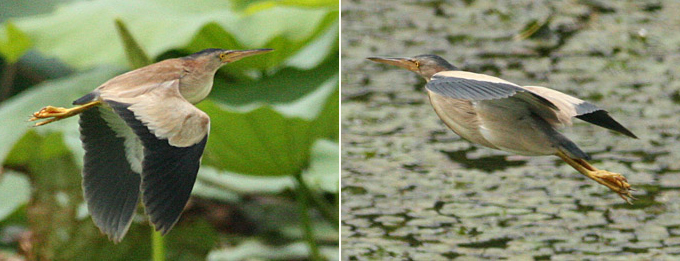
The report of the flagged godwit was sent by Tim Edelsten to Clive Minton of the AWSG, and the following reply was recieved 23 August 2006:
A Black-tailed Godwit Limosa limosa was sighted in a flock of 100 birds by Tim Edelsten, Robin Newlin, Jake McClennan, and Peter Nebel at: Geum River Estuary, Chungham Province, Republic of Korea (South Korea) 36deg 2min 1sec N, 126deg 44min0sec E on 20/08/2006 with flag(s) as follows:
LEFT leg: nothing/unknown on tibia (upper leg) above nothing/unknown on tarsus
RIGHT leg: yellow flag on tibia (upper leg) above nothing/unknown on tarsus
This bird was flagged in North-west Australia, approximate co-ordinates 19deg0min S, 122deg0min E, which uses the flag combination Yellow, sometime since August 1992.
The resighting was a distance of approximately 6141 km, with a bearing of 5 degrees, from the marking location.
Igidae, Busan, August 19
With the passage of a rapidly weakening typhoon/tropical depression moving through the SE of Korea into the East Sea, 3 hours seawatching at the coast.
In the first hour, before heavy rain moved in, 1030 Streaked Shearwater were counted moving north, along with the day's highlight: 1 or 2 Swinhoe's Storm Petrel (regular at sea, sightings from the mainland are presumably exceptional). In the following hour, as the wind moderated further and shifted from NE to NW, the numbers of shearwater started to fall away, with only 320 logged moving north, before heavy rain reduced visibility further (eventually down to a few hundred metres).
Other species of note included ca 30 Red-necked Phalarope (all adults sitting on the sea), a total of ca 35 Common Tern (including several juveniles) and single Grey Plover, Grey-tailed Tattler, Spot-billed Duck and Peregrine moving north.
Most intriguing was an apparently medium-sized gull watched for 2 minutes as it struggled north in very poor viewing conditions. In direct comparison with Black-tailed Gulls it looked small, flew with more rapid and deeper wingbeats, and showed an upperwing pattern suprisingly suggestive of Sabine's Gull (even if somewhat uneven-looking). Checking a nearby gull roost an hour later, 93 Black-headed Gull were rather unexpected on this early date, while even more interesting was one very bleached and worn Black-tailed Gull (in among ca 300 others). Through wear, it almost lacked a tail band (making it appear suprisingly small), and its upperwing had clean white-looking secondaries, blackish primaries and dark grey coverts...obviously the same Sabine's-patterned individual as watched an hour earlier. According to Park's doctoral thesis there is only one accepted record of Sabine's Gull in Korea: a sight record on 30 August 1970...
Igidae, Busan, August 17
In strengthening NE winds (now Beaufort force 4, gusting 5), another 90 minutes of late afternoon seawatching. No especial highlights, with the gully empty of migrants, and 130 Streaked Shearwater and 43 Common-type Terns north (all movement was southward on 16/08), and at least 205 Black-tailed Gull south.
Igidae, Busan, August 16
With the first decent breeze in almost 10 days (a force 3 northeasterly) generated by a weak typhoon moving into southern Japan, a couple of hours in the late afternoon on the east coast of Busan.
In one very densely vegetated gully, single Black-naped Oriole, juvenile (presumed) Little Cuckoo and "color-rumped" flycatcher (either Narcissus or Yellow-rumped) all glimpsed only, while an hour's seawatching produced 115 Streaked Shearwater south, and at least 5 jaegers: these included at least one adult Pomarine (with full spoons), one fairly close-in Parasitic (perhaps second summer), apparently being harrassed by shearwaters, and one adult-type Long-tailed Jaeger. The latter, probably much overlooked, is a very rarely reported species in South Korean waters. Scoped as it flew south low down over the waves ca 200-300m offshore, it was strikingly lightly-built, lacked any darker breast markings, instead darkening gradually on the underparts towards the vent, and showed apparently all dark underwings with only a trace of white on the upperside of the primaries. Tail streamers were looked for but not seen.
Two much more distant jaeger, either Pomarine or Parasitic, were left unidentified.
Songdo, August 15
Similar birds to last week, however some new arrivals: 2 Mandarin on the lagoon. At Ahamdo, just-arrived influxes of Eurasian Curlews, Whimbrels, Terek Sandpipers, 50+ new-in Grey Plovers, and 3 Grey-tailed Tattlers. 2 Little Terns remain, although the majority departed weeks ago.
Best was good views of a Chinese Egret and an "abandoned" juvenile Saunders's Gull feeding rather clumsily.
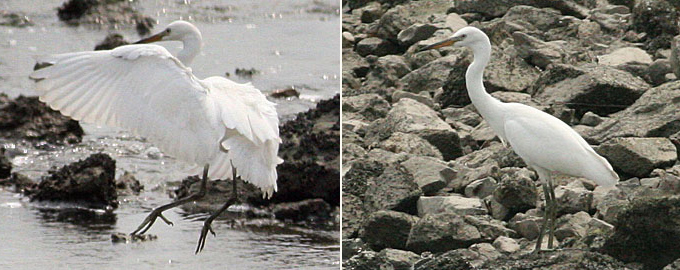
Gunsan Vicinity, August 13
Spotted Redshanks and at least one Common Redshank (PN) were on the Geum Tidal Flats. In the Industrial Zone Wood Sandpipers and a single Marsh Sandpiper were present. Near the canal a Zitting Cisticola was observed. Hundreds of Black-tailed Godwits and large numbers of Great Knots were seen from Okku.
We checked behind the Gunsan Nurse's College again and determined at least five Chinese Pond Herons were in and around the pond there. We have good reason to think there has been a successful brood there this summer, as a couple of them are in transition from breeding plumage while the others observed appeared to be in winter plumage.
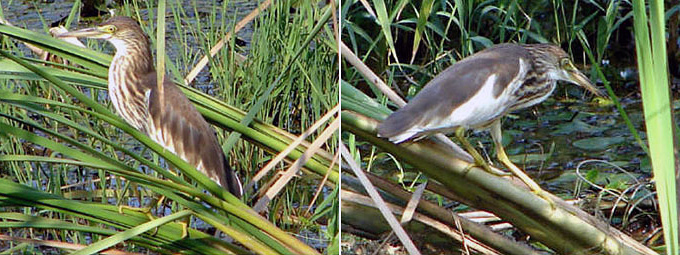
Cheorwon, August 12
The reservoir has practically evaporated in the heat, after being flooded only 2 weeks ago. On the freshly exposed sandbars, a surprising array of waders at this far inland freshwater site, many apparently arriving and falling from the sky: 7 Pacific Golden Plovers, 5 Green Sandpipers, 6 Red-necked Stints, 10+ Terek Sandpipers, 1 Far Eastern Curlew, 1 Wood Sandpiper, 1 Dunlin, 2 Common Sandpipers, 2 Common Redshank, and 6 Common Greenshanks. Also, a Black-capped and several Common Kingfishers.
Other fauna included plentiful slots of Korean water deer Hydropotes inermis argyropus, excellent views of a Siberian Weasel Mustela siberica coreana, and a Tiger keelback snake Rhabdophis tigrinus lateralis.
Songdo, August 8
Autumnal passage is underway and a host of waders have descended on the lagoon: 32 Black-tailed Godwits, 8 Common Sandpipers,1 Spotted Redshank, 2 Marsh Sandpipers, 2 Common Redshank, 1 Wood Sandpiper, c.50 Common Greenshank, a scattering of Mongolian Gulls and 2 fledgling Saunders's Gulls.
At Aham-do, 6 Far Eastern Curlew, a Whimbrel, 4 Chinese Egret, up to 300 Common Greenshanks, 7 Sharp-tailed Sandpipers, c.40 Bar-tailed Godwits, 16 Grey Plovers, 2 Pacific Golden Plovers. Most encouragingly, 133 adult and 22 juvenile Saunders's Gulls, the fledglings constantly begging food from their parents.
Nakdong Estuary Shorebird Survey & Monitoring Program, August 7
In intense sunlight and heat (with a maximum temperature again reaching 33C), 8 or 9 hours of boat-based shorebird counting, covering almost all of the estuary.

While 18 species of shorebird were logged, numbers were not especially high. Most numerous were Sanderling (392), Kentish Plover (309), Eurasian Curlew (170), Red-necked Stint (150), Grey Plover (62) and Grey-tailed Tattler (ca 60). Other shorebirds of note included 18 Mongolian and 5 Greater Sand Plover, 2 Sharp-tailed Sandpiper, an Eastern Oytercatcher, probably 10 Bar-tailed Godwit (at least 5 of which were menzbieri based on rump pattern) and excellent views of 14 Great Knot.
While there were no terns at all in the estuary (with the large Little Tern breeding colony departing the estuary in late July), there were fair numbers of gulls, including 5 Slaty-backed, 1 Vega and most surprising of all a single third summer Glaucous Gull (possibly unrecorded in Korea in summer?).
The other outstanding highlight was a group of three Chinese Egret, one adult and two juveniles close in tow, suggesting local breeding.

Geum Tidal Flats, Oh-seong Mountain, Okku, and Gunsan vicinity, August04
A few Bar-tailed Godwits were at the Geum. Eurasian and Far Eastern Curlews as well as a Whimbrel (PN) rounded out the common Numenius. A Common Kingfisher perched on a boat there. Around Oh-seong Mountain several Striated Herons were seen. Moorhens there seem to be a few weeks along in their second brood.
In the Industrial Zone a small group of Green Sandpipers was seen. A couple of Yellow Bitterns were near a shallow pond. The Little Terns have cleared out of their colony; a few were seen feeding over the Saemangeum. At Okkuu a large number of mixed shore birds were seen on the reduced mud flats, including hundreds of Black-tailed Godwits, large numbers of Great Knots, a scattering of Red Knots and Mongolian Plovers. A few Ruddy Turnstones were spread out over the flats as well as some Red-necked Stints and Dunlins. In a fresh water canal nearby some Spotted Redshanks and a few more Green Sandpipers were seen.
Behind the Gunsan Nurses College at least three Chinese Pond Herons (perhaps more) were observed. A few Red-rumped Swallows were there also.
Geoff Stiles and Peter Nebel continued onto the city reservoir to sight the male Watercock that has been spending the summer there.
Yanngu, August 4
Sad to see extensive concreting now underway along the formerly untouched rivers of Gangwon-do.
In thick mountain forest, a Black-capped Kingfisher, families of Yellow-throated Buntings and Daurian Redstarts, and a White- backed Woodpecker.
At dusk (and moments after I had put my camera away), an adult and then a juvenile Eurasian Eagle Owl emerged. Resting on the warm road before flying up, a Grey Nightjar was a pleasant surprise.
Uiwang, August 3
A simmering heatwave has hit Korea full force now. On the reservoir, 6 Coot included 1 juvenile. Also 9 Common Moorhen comprising 5 youngsters and 4 adults, 2 Little Grebe and a pair of Great-crested Grebes with a striped white chick at the nest. Also the Common Kingfisher family, Cattle Egrets and Oriental Reed Warblers.
Images recently released of three 'firsts' for Korea from May 2006 (Asian Drongo Cuckoo Surniculus lugubris, House Sparrow Passer domesticus and Spotted Dove Streptopelia chinensis), and a Pied Wheatear forwarded to Birds Korea from April 2006 (all records have also been posted on the respective monthly Latest News pages, with the three new firsts added to Category One of the Birds Korea checklist).
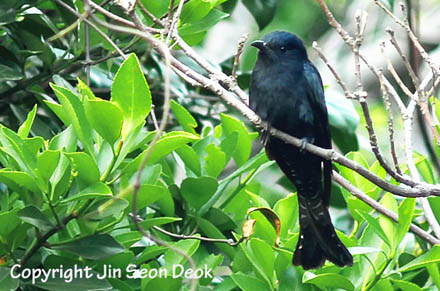
Photo © Jin Seon Deok
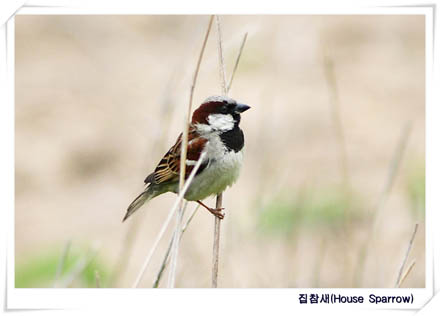
Photo © Kim Sung-Hyun (National Parks Migratory Bird Centre)
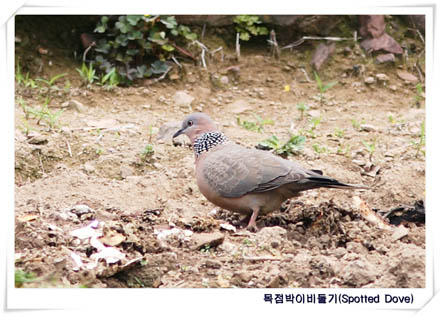
Photo © Kim Sung-Hyun (National Parks Migratory Bird Centre)
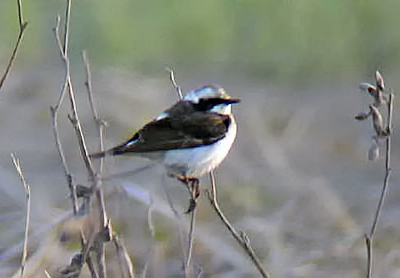
Photo © Peter Nebel
Asian Drongo Cuckoo Surniculus lugubris, adult, 4 May 2006, Hong Island found and photographed by Jin Seon Deok, with identification confirmed (and permission given to post the photograph below) by Kim Sung-Hyun and Park Jong-Gil of the National Parks Migatory Bird Center (Hong Island).
House Sparrow Passer domesticus, Male, 18 May 2006, Heuksan Island. Found by Kim Eun-Mi and photographed by Kim Sung-Hyun (National Parks Migratory Bird Centre).
The House Sparrow has been proposed as two species, House Sparrow Passer domesticus and Indian Sparrow Passer indicus (e.g. Stepanyan 1990: Conspectus of the Ornithological Fauna of the USSR), or as one species containing two groups of sub-species (Clement et al 1993, Finches & Sparrows): a 'Palearctic group', comprising ssps domesticus (including 'balearoibericus'), biblicus, persicus, tingitanus, and niloticus and an 'Oriental group', comprising ssps hyrcanus, indicus, bactrianus, parkini, hufufae, and rufidorsalis. Both groups are considered to differ somewhat in ecology, timing of moult, and behaviour, with the indicus group generally smaller, neater (with smaller bills), and the male's plumage whiter (or paler grey) on the cheeks, ear-coverts, side of neck and underparts, with extensive deep chestnut (more reddish-brown tone) on the upperparts. Within this 'Oriental group' some subspecies are considered to be largely sedentary, and others, like the larger-billed, paler below bactrianus from e.g. NW Xinjiang /Tien Shan, perhaps largely migratory. (All information from the literature above kindly provided by Richard Klim).
Based on the plumage of the Heuksan bird (with its very pale underparts, white “cheeks,” and strongly reddish-brown tones to some of the upperparts), it is apparently possible to assign this first record to the indicus 'Oriental group'. Lacking measurements, further details on plumage differences or expert opinion, however, it appears unwise at this time to assign it more precisely to subspecies (opinions of those with experience of the various subspecies are of course most welcome).
Of some further interest, while the House Sparrow is declining across much of its historic range, it is believed to be spreading eastward in Asia, being first recorded for example in 1990 in Japan (Brazil, 1990), and in 2000 in Viet Nam (a pair in Tan Hung District, Tram Chim, on March 14, 2000: N. Moores, pers. obs).
Spotted Dove Streptopelia chinensis (nominate subspecies), Adult, 23 May, Hong-Do. Found by Park Jong-Gil, photographed by Kim Sung-Hyun (National Parks Migratory Bird Centre). Seen a second time on May 30.
Also belated record from Peter Nebel:
Pied Wheatear: First summer male, Gunsan (mainland), April 21: Peter Nebel, Angela Pacheco, Jim Levenson. This is considered the 4th Korean record, (and the 3rd record for South Korea) and the first of a remarkable five recorded in 2006.
Records of Pied Wheatear Oenanthe pleschanka on the Korean peninsula known to Birds Korea:
Female, collected, 21 April, 1956: Jangjin, Hamgyeong South, (north-east) DPRK (Won Hong-Koo in Tomek, 2000). Note: on the basis of this record, Black-eared Wheatear Oenanthe hispanica is erroneously included in Lee, Koo and Park (2000), the LG Evergreen "A Field Guide to Birds of Korea".
7-14 May, 1988, Ganghwa Island, Gyeonggi (Adrian Long, in Park, 2002)
Female, photographed, 21 April – 27 April 2003. (N. Moores et al, 2003)
First summer male, photographed, 21 April, 2006, Gunsan. Photographed. (P. Nebel, A. Pacheco, J. Levenson).
First summer male, photographed, 21 April -24 April (at least), 2006, Eocheong Island, Gunsan. Photographed. (T. Edelsten, N. Moores, J. Geale)
Male, Hong Do, Shinnan-Gun, photographed, 25 April, 2006 (National Parks Migratory Bird Centre)
Female, Eocheong Island, Gunsan, photographed, 27 April, 2006 (via Park Jong-Gil: National Parks Migratory Birds centre).
Female, Hong Do, Shinnan-Gun, photographed, 8 May, 2006 (National Parks Migratory Birds Centre).





